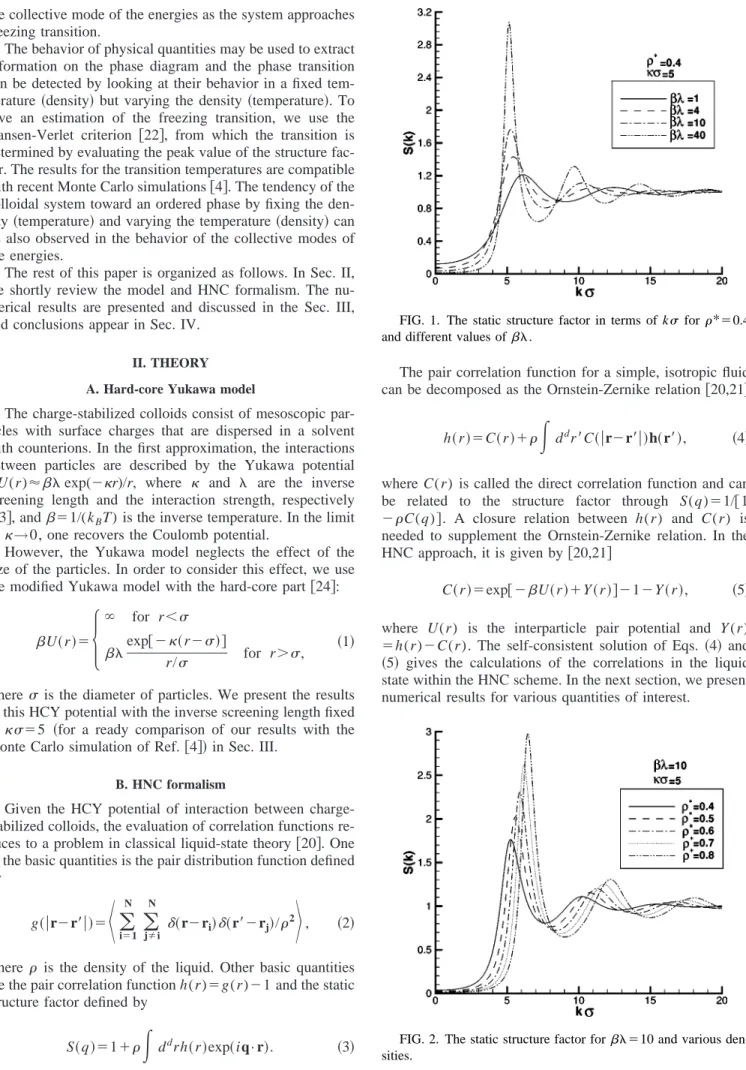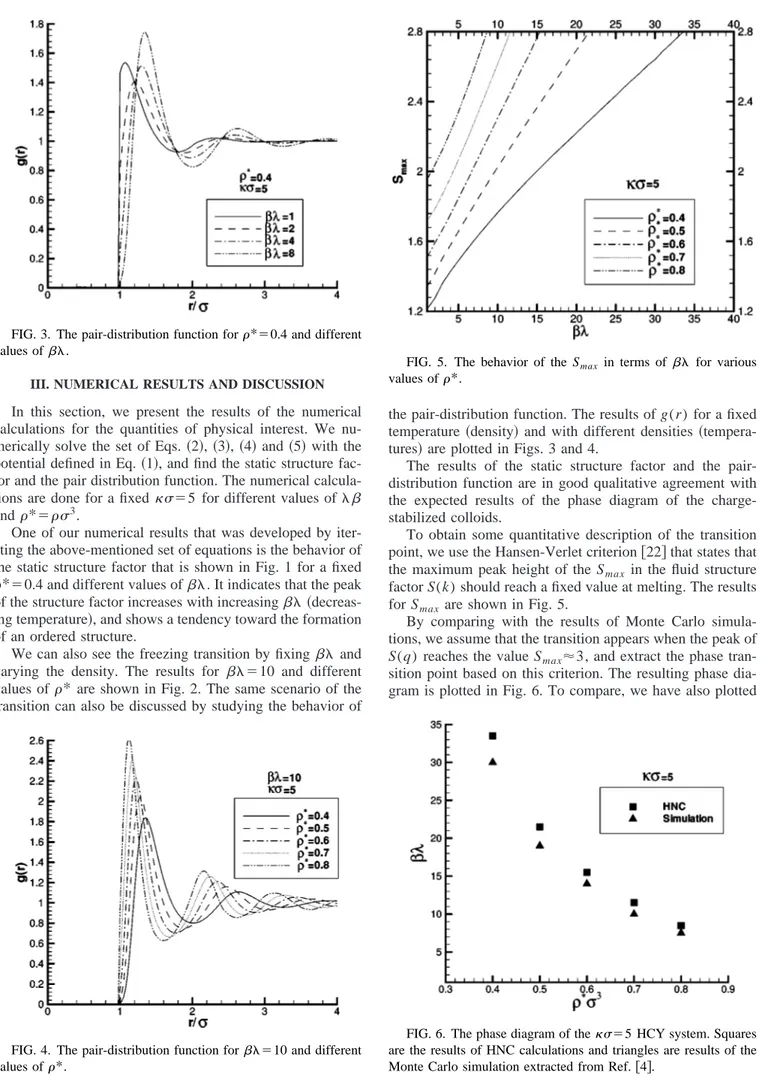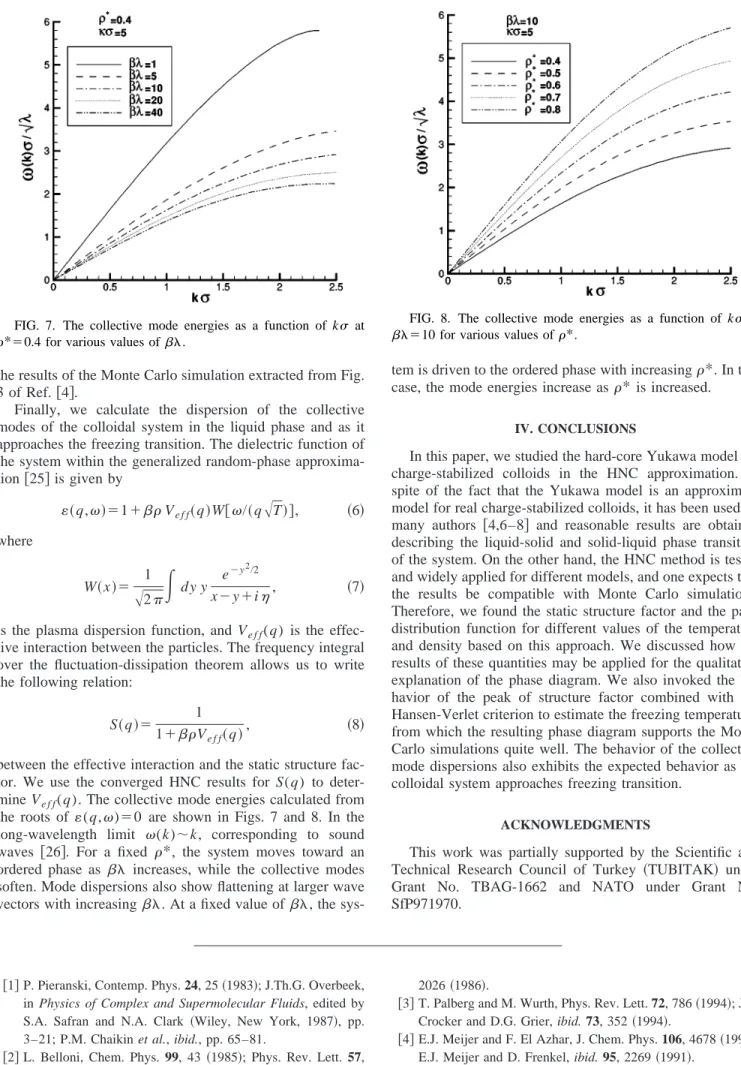Hard-core Yukawa model for charge-stabilized colloids
B. Davoudi,1M. Kohandel,1,2M. Mohammadi,3and B. Tanatar4 1Institute for Studies in Theoretical Physics and Mathematics, Tehran 19395-5531, Iran 2Department of Physics, University of Waterloo, Waterloo, Canada N2L3G1 3Department of Chemistry, Islamic Azad University, North Branch, Tehran, Iran
4Department of Physics, Bilkent University, Bilkent, Ankara 06533, Turkey 共Received 4 July 2000兲
The hypernetted chain approximation is used to study the phase diagram of a simple hardcore Yukawa model of a charge-stabilized colloids. We calculate the static structure factor, the pair distribution function, and the collective mode energies over a wide range of parameters, and the results are used for studying the freezing transition of the system. The resulting phase diagram is in good agreement with the known estimates and the Monte Carlo simulations.
PACS number共s兲: 82.70.Dd, 64.70.Dv
I. INTRODUCTION
The phases of the charge-stabilized colloids have become a subject of growing interest in many recent experimental and theoretical investigations 关1–5兴. However, it is fair to say that our understanding of charge-stabilized colloids is very far from complete, and even some basic questions such as what is the form of interactions between strongly charged colloidal particles still remains controversial 关6–8兴. On the other hand, it seems to be quite well-known that when the concentration of colloids is sufficiency large it freezes into a crystal. Both body-centered-cubic 共bcc兲 and face-centered-cubic 共fcc兲 crystals have been found. Therefore, the full phase diagram consists of two melting lines共liquid-bcc solid and liquid-fcc solid兲 and a structural 共bcc-fcc兲 transition, de-pending on the effective temperature and inverse screening length 关4兴.
There have been a number of approaches for studying the phase diagram of the charge-stabilized colloids using a vari-ety of analytical and simulation studies 关4–11兴. Most ap-proaches rely on using a one-component system of spherical particles interacting via a simple pair potential, consisting of a hard sphere interaction plus a repulsive Yukawa term, called hard-core Yukawa共HCY兲 potential. Since this poten-tial is purely repulsive, it can give rise to a single fluid phase that can freeze into a solid with either an fcc or a bcc struc-ture 关4兴.
The phase diagram of particles interacting via a Yukawa potential is of special interest, since it has been applied to a wide range of the physical systems, and also it provides a good testing ground for theories of the phase transitions 关6,12兴. There are a number of theoretical and Monte Carlo studies to discuss the freezing behavior of the particles inter-acting via a pure Yukawa potential 关2,7,8,13,14兴. On the other hand, various theoretical and numerical works have studied the phase behavior of the HCY model关9,11,15–18兴. The later case共which we study in this paper兲 may provide an understanding of the phase diagram of the charged-stabilized colloidal particles for which the colloid-colloid interactions can to some extent be represented by this HCY model. Here, the hardcore term represents the finite size of the colloidal
particles while the Yukawa terms represents the repulsive electrostatic interaction.
Kloczkowski and Samborski 关15兴 studied the freezing of hard spheres with a Yukawa attractive or repulsive potential in the mean spherical approximation by using the density functional theory. A simple theory was proposed in Ref.关8兴 to find the location of the phase boundary of the repulsive Yukawa potential. The thermodynamics of the fluid and solid one-component plasma with the Yukawa potential has been also studied in detail from molecular dynamics in Ref.关14兴. On the other hand, many works have discussed the HCY potential. The phase diagram of the HCY mixtures, consti-tuted of equal-sized hard spheres, determined in the Ref.关10兴 by means of Gibbs ensemble Monte Carlo simulations, semi-grand canonical Monte Carlo simulations, and through the modified hypernetted-chain theory. The self-consistence Ornstein-Zernike approximation, the generalized mean spherical approximation, the modified hypernetted-chain proximation, and the hierarchical reference theory were ap-plied to the determination of thermodynamics and structural properties, and the phase diagram of the HCY fluid by Cac-camo et al. 关13兴 Thermodynamically self-consistent integral equation theories supplemented by a one-phase freezing cri-terion, and Monte Carlo simulations were used in Ref. 关18兴 to investigate the thermodynamics and structural properties, and phase diagram of the HCY fluid. The results of Monte Carlo simulations and an analytical theory for HCY fluids of variable range was presented by Shukla 关11兴. A two-dimensional Clapeyron integration was used in Ref. 关9兴 for the HCY potential of variable range to compute the line of triple points. The results for the triple point of the Yukawa system are also given in the Ref. 关19兴.
In this paper, we use the well-tested and widely applied hypernetted-chain 共HNC兲 formalism 关20,21兴 to study the freezing transition of the charge-stabilized colloidal particles interacting via HCY potential. Our primary aim is to clarify how well the HNC approach models the static properties of the HCY particles. To this end, we calculate the static struc-ture factor and the pair correlation function for different den-sities and temperatures. The results are often compared with the available Monte Carlo simulations, from which a good agreement between the results are observed. We also discuss PRE 62
the collective mode of the energies as the system approaches freezing transition.
The behavior of physical quantities may be used to extract information on the phase diagram and the phase transition can be detected by looking at their behavior in a fixed tem-perature 共density兲 but varying the density 共temperature兲. To give an estimation of the freezing transition, we use the Hansen-Verlet criterion 关22兴, from which the transition is determined by evaluating the peak value of the structure fac-tor. The results for the transition temperatures are compatible with recent Monte Carlo simulations关4兴. The tendency of the colloidal system toward an ordered phase by fixing the den-sity共temperature兲 and varying the temperature 共density兲 can be also observed in the behavior of the collective modes of the energies.
The rest of this paper is organized as follows. In Sec. II, we shortly review the model and HNC formalism. The nu-merical results are presented and discussed in the Sec. III, and conclusions appear in Sec. IV.
II. THEORY A. Hard-core Yukawa model
The charge-stabilized colloids consist of mesoscopic par-ticles with surface charges that are dispersed in a solvent with counterions. In the first approximation, the interactions between particles are described by the Yukawa potential
U(r)⬇ exp(⫺r)/r, where and are the inverse screening length and the interaction strength, respectively 关23兴, and⫽1/(kBT) is the inverse temperature. In the limit
of →0, one recovers the Coulomb potential.
However, the Yukawa model neglects the effect of the size of the particles. In order to consider this effect, we use the modified Yukawa model with the hard-core part 关24兴:
U共r兲⫽
再
⬁ for r⬍
exp关⫺r/共r⫺ 兲兴 for r⬎, 共1兲
where is the diameter of particles. We present the results of this HCY potential with the inverse screening length fixed at ⫽5 共for a ready comparison of our results with the Monte Carlo simulation of Ref. 关4兴兲 in Sec. III.
B. HNC formalism
Given the HCY potential of interaction between charge-stabilized colloids, the evaluation of correlation functions re-duces to a problem in classical liquid-state theory关20兴. One of the basic quantities is the pair distribution function defined by g共兩r⫺r⬘兩兲⫽
冓
兺
i⫽1 N兺
j⫽i N ␦共r⫺ri兲␦共r⬘⫺rj兲/2冔
, 共2兲where is the density of the liquid. Other basic quantities are the pair correlation function h(r)⫽g(r)⫺1 and the static structure factor defined by
S共q兲⫽1⫹
冕
ddrh共r兲exp共iq•r兲. 共3兲The pair correlation function for a simple, isotropic fluid can be decomposed as the Ornstein-Zernike relation 关20,21兴
h共r兲⫽C共r兲⫹
冕
ddr⬘
C共兩r⫺r⬘兩兲h共r⬘兲, 共4兲 where C(r) is called the direct correlation function and can be related to the structure factor through S(q)⫽1/关1 ⫺C(q)兴. A closure relation between h(r) and C(r) is needed to supplement the Ornstein-Zernike relation. In the HNC approach, it is given by关20,21兴C共r兲⫽exp关⫺U共r兲⫹Y共r兲兴⫺1⫺Y共r兲, 共5兲 where U(r) is the interparticle pair potential and Y (r) ⫽h(r)⫺C(r). The self-consistent solution of Eqs. 共4兲 and 共5兲 gives the calculations of the correlations in the liquid state within the HNC scheme. In the next section, we present numerical results for various quantities of interest.
FIG. 1. The static structure factor in terms of k for *⫽0.4
and different values of.
FIG. 2. The static structure factor for⫽10 and various den-sities.
III. NUMERICAL RESULTS AND DISCUSSION In this section, we present the results of the numerical calculations for the quantities of physical interest. We nu-merically solve the set of Eqs.共2兲, 共3兲, 共4兲 and 共5兲 with the potential defined in Eq.共1兲, and find the static structure fac-tor and the pair distribution function. The numerical calcula-tions are done for a fixed⫽5 for different values of  and*⫽3.
One of our numerical results that was developed by iter-ating the above-mentioned set of equations is the behavior of the static structure factor that is shown in Fig. 1 for a fixed
*⫽0.4 and different values of. It indicates that the peak of the structure factor increases with increasing 共decreas-ing temperature兲, and shows a tendency toward the formation of an ordered structure.
We can also see the freezing transition by fixing and varying the density. The results for ⫽10 and different values of* are shown in Fig. 2. The same scenario of the transition can also be discussed by studying the behavior of
the pair-distribution function. The results of g(r) for a fixed temperature 共density兲 and with different densities 共tempera-tures兲 are plotted in Figs. 3 and 4.
The results of the static structure factor and the pair-distribution function are in good qualitative agreement with the expected results of the phase diagram of the charge-stabilized colloids.
To obtain some quantitative description of the transition point, we use the Hansen-Verlet criterion关22兴 that states that the maximum peak height of the Smax in the fluid structure factor S(k) should reach a fixed value at melting. The results for Smax are shown in Fig. 5.
By comparing with the results of Monte Carlo simula-tions, we assume that the transition appears when the peak of S(q) reaches the value Smax⬇3, and extract the phase tran-sition point based on this criterion. The resulting phase dia-gram is plotted in Fig. 6. To compare, we have also plotted
FIG. 3. The pair-distribution function for*⫽0.4 and different
values of.
FIG. 4. The pair-distribution function for⫽10 and different values of*.
FIG. 5. The behavior of the Smax in terms of for various
values of*.
FIG. 6. The phase diagram of the⫽5 HCY system. Squares are the results of HNC calculations and triangles are results of the Monte Carlo simulation extracted from Ref.关4兴.
the results of the Monte Carlo simulation extracted from Fig. 3 of Ref. 关4兴.
Finally, we calculate the dispersion of the collective modes of the colloidal system in the liquid phase and as it approaches the freezing transition. The dielectric function of the system within the generalized random-phase approxima-tion 关25兴 is given by 共q,兲⫽1⫹Ve f f共q兲W关/共q
冑
T兲兴, 共6兲 where W共x兲⫽ 1冑
2冕
d y y e⫺y2/2 x⫺y⫹i, 共7兲 is the plasma dispersion function, and Ve f f(q) is the effec-tive interaction between the particles. The frequency integral over the fluctuation-dissipation theorem allows us to write the following relation:S共q兲⫽ 1
1⫹Ve f f共q兲, 共8兲 between the effective interaction and the static structure fac-tor. We use the converged HNC results for S(q) to deter-mine Ve f f(q). The collective mode energies calculated from the roots of (q,)⫽0 are shown in Figs. 7 and 8. In the long-wavelength limit (k)⬃k, corresponding to sound waves 关26兴. For a fixed *, the system moves toward an ordered phase as  increases, while the collective modes soften. Mode dispersions also show flattening at larger wave vectors with increasing. At a fixed value of, the
sys-tem is driven to the ordered phase with increasing*. In this case, the mode energies increase as *is increased.
IV. CONCLUSIONS
In this paper, we studied the hard-core Yukawa model for charge-stabilized colloids in the HNC approximation. In spite of the fact that the Yukawa model is an approximate model for real charge-stabilized colloids, it has been used by many authors 关4,6–8兴 and reasonable results are obtained describing the liquid-solid and solid-liquid phase transition of the system. On the other hand, the HNC method is tested and widely applied for different models, and one expects that the results be compatible with Monte Carlo simulations. Therefore, we found the static structure factor and the pair-distribution function for different values of the temperature and density based on this approach. We discussed how the results of these quantities may be applied for the qualitative explanation of the phase diagram. We also invoked the be-havior of the peak of structure factor combined with the Hansen-Verlet criterion to estimate the freezing temperature, from which the resulting phase diagram supports the Monte Carlo simulations quite well. The behavior of the collective mode dispersions also exhibits the expected behavior as the colloidal system approaches freezing transition.
ACKNOWLEDGMENTS
This work was partially supported by the Scientific and Technical Research Council of Turkey 共TUBITAK兲 under Grant No. TBAG-1662 and NATO under Grant No. SfP971970.
关1兴 P. Pieranski, Contemp. Phys. 24, 25 共1983兲; J.Th.G. Overbeek, in Physics of Complex and Supermolecular Fluids, edited by S.A. Safran and N.A. Clark 共Wiley, New York, 1987兲, pp. 3–21; P.M. Chaikin et al., ibid., pp. 65–81.
关2兴 L. Belloni, Chem. Phys. 99, 43 共1985兲; Phys. Rev. Lett. 57,
2026共1986兲.
关3兴 T. Palberg and M. Wurth, Phys. Rev. Lett. 72, 786 共1994兲; J.C. Crocker and D.G. Grier, ibid. 73, 352共1994兲.
关4兴 E.J. Meijer and F. El Azhar, J. Chem. Phys. 106, 4678 共1997兲; E.J. Meijer and D. Frenkel, ibid. 95, 2269共1991兲.
FIG. 7. The collective mode energies as a function of k at
*⫽0.4 for various values of.
FIG. 8. The collective mode energies as a function of k at
关5兴 N. Choudhury and S.K. Ghosh, Phys. Rev. E 51, 4503 共1995兲. 关6兴 M.J. Stevens and M.O. Robbins, J. Chem. Phys. 98, 2319
共1993兲.
关7兴 C.F. Tejero et al., Phys. Rev. A 46, 3373 共1992兲. 关8兴 P.S. Khun et al., Physica A 247, 235 共1997兲. 关9兴 F. El Azhar et al., J. Chem. Phys. 112, 5121 共2000兲. 关10兴 C. Caccamo, D. Costa, and G. Pellicane, J. Chem. Phys. 109,
4498共1998兲.
关11兴 K.P. Shukla, J. Chem. Phys. 112, 10 358 共2000兲. 关12兴 C. Caccamo, Phys. Rep. 274, 1 共1996兲.
关13兴 D.C. Wang and A.P. Gast, J. Chem. Phys. 112, 2826 共2000兲. 关14兴 R.T. Farouki and S. Hamaguchi, J. Chem. Phys. 101, 9885
共1994兲.
关15兴 A. Kloczkowski and A. Samborski, J. Chem. Phys. 88, 5834 共1988兲.
关16兴 M. Renkin and J. Hafner, J. Non-Cryst. Solids 117, 894 共1990兲.
关17兴 C. Caccamo et al., Phys. Rev. E 60, 5533 共1999兲.
关18兴 C. Caccamo et al., J. Phys.: Condens. Matter 12, A437 共2000兲. 关19兴 S. Hamaguchi, R.T. Farouki, and D.H.E. Dubin, Phys. Rev. E
56, 4671共1997兲.
关20兴 J.P. Hansen and D.R. Mcdonald, Theory of Simple Liquids, 2nd ed.共Academic, London, 1986兲.
关21兴 G.I. Menon et al., Phys. Rev. B 54, 16192 共1996兲. 关22兴 J.P. Hansen and L. Verlet, Phys. Rev. 184, 151 共1969兲. 关23兴 W.B. Russel, D.A. Savile, and W.R. Schowalter, Colloidal
Dispersions 共Cambridge University Press, Cambridge, En-gland, 1991兲.
关24兴 H.N.W. Lekkerkerker, in Structure and Dynamics of Strongly Interacting Colloids and Supramolecular Agregates in Solu-tion, Vol. 369 of NATO Advanced Studies Institute, edited by S.H. Chen, J. Huang, and P. Tartaglia 共Kluwer, Academic, Dordrecht, 1992兲, pp. 97–109.
关25兴 N. Studart and H.V. da Silveira, Phys. Rev. E 53, 2350 共1996兲. 关26兴 J.L. Barrat, J.P. Hansen, and H. Totsuji, J. Phys. C 21, 4511


